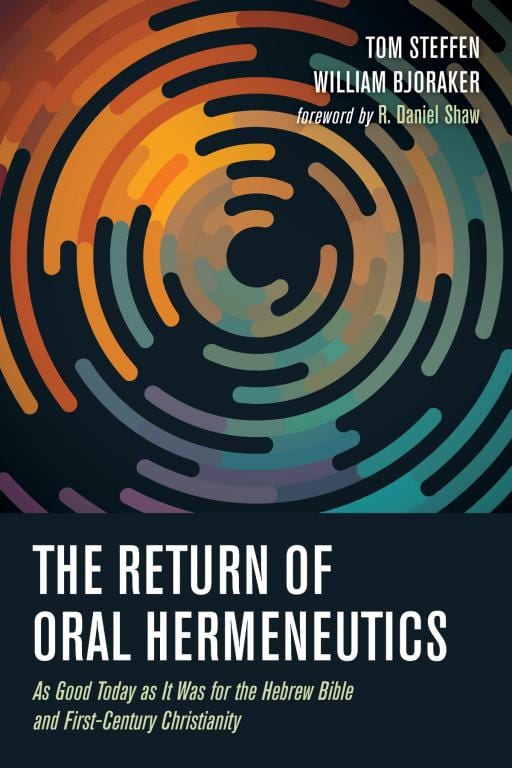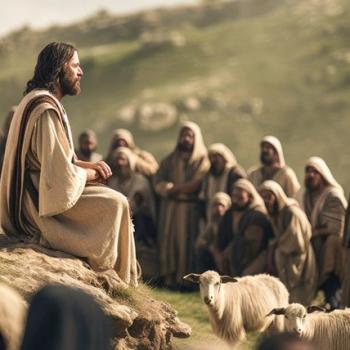Today’s guest post comes from my friend and scholar, Tom Steffen, who served twenty years with New Tribes Mission. He is an emeritus professor of Intercultural Studies at Biola University. He introduces us to his new book Oral Hermeneutics.
His first post provided the backstory of The Return of Oral Hermeneutics: As Good Today as it Was for the Hebrew Bible and First-Century Christianity.

This second post looks at the central question that shapes our introductory book on the topic of oral hermeneutics:
Why is it important to know and practice oral hermeneutics in ascertaining and communicating biblical meaning?
To answer that question, we outlined the book this way:
Setting the Stage
Part 1 Demonstrations
1 Elisha and the Widow’s Oil
2 Reflections on the Elisha Story
Part 2 Propositions
3 Orality’s Influence on Text and Teaching
4 Oral Hermeneutics
5 Hebrew Hermeneutics
6 Character Theology
7 Questioning Our Questions
8 Reflections
Part 3 Echoes
9 Elisha and General Naaman
10 Reflections on the Elisha Story
Concluding Reflections
Part 1 Demonstrations
Part 1 demonstrates what the authors will later define. Did you catch the order?
The authors model what is argued throughout the book—build from the concrete to the abstract. Yes, there is a sequence, but without implying that one is superior over the other.
We begin making the case for the return of oral hermeneutics by challenging the long-held comfortable conclusions of textual hermeneutics. Chapter 1 provides a concrete example of the use of oral hermeneutic via an oral inductive Bible study of the story of “Elisha and the Widow’s Oil.” This chapter foregrounds, embodies, and demonstrates what follows in the book. Chapter 2 summarizes key reflections from the Bible story that we will later develop and expand.
The two oral inductive story presentations in Chapters 1 and 9 serve as bookends of practice that enclose theory. Sandwiching the theory between the two slices of bread (i.e., the practice of oral storying) honors story as the dominant genre of Scripture, and the primary expression of oral hermeneutics.
Part 2 Propositions
Part 2 lays out our propositional proposals on oral hermeneutics based on the clues partially provided from the story of “Elisha and the Widow’s Oil.” It reviews how the canon evolved from voice to text, how the spoken and written Word interfaced, and how these are significant for oral hermeneutics today. Over time, of course, scientific logic, linear thought, theorizing, atomized textual analysis, propositions (as the main product of biblical interpretation) and systematic theology dominated, extending to today.
The central question in Chapter 3 asks, “How did orality influence text and teaching?” To answer this question, the authors consider how orality and text interfaced before, during, and postconstruction of the canon, something often overlooked in relation to hermeneutics. In the search for a new way to theologize, we mull over orality, the role of scribes, individual and collective memory, and how manuscripts were delivered and discussed.
 Chapter 4 offers a possible course correction to what some consider the “settled science” of textual hermeneutics. The authors do so without entirely jettisoning established scholarship. The chapter calls for dialogue between proponents of oral hermeneutics and textual hermeneutics.
Chapter 4 offers a possible course correction to what some consider the “settled science” of textual hermeneutics. The authors do so without entirely jettisoning established scholarship. The chapter calls for dialogue between proponents of oral hermeneutics and textual hermeneutics.
It calls for a new (actually an old) hermeneutic that specifically addresses the literary portions of Scripture, making Scripture more accessible and meaningful to a large and growing audience of oral-preference learners worldwide. It lays out a definition and the need for oral hermeneutics.
Interestingly, what the authors discussed and called for in the former chapter (“Oral Hermeneutics”) existed centuries prior. Chapter 5 reviews Hebrew hermeneutics. It highlights the distinctions between textual hermeneutics and oral hermeneutics, taking cues from the first custodians of Scripture, i.e., the rabbis, scholars, and teachers of the Jewish people.
Chapter 6 proposes a different type of theologizing and theology that goes beyond but does not discard systematic theology, biblical theology, or narrative theology. The goal is character theology. This chapter addresses how oral hermeneutics, driven by narrative logic (in contrast to propositional logic), relies on character theologizing (process) that results in character theology (product) so that we can build an initial and ongoing relationship with the Chief Character—Jesus.
Chapter 7 delves into the questions currently being used in many prominent Bible storying models today, such as Discovery Bible Study (DBS), T4T (Training for Trainers), OT4T (Orality Training for Trainers), S-T4T (Storying Training for Trainers), DMM (Disciple-Making Movements), STS (Simply the Story), among others. This chapter offers more character-centric questions.
Part 2 concludes with Chapter 8 by reviewing and reflecting on the challenges and contributions of oral hermeneutics highlighted in Chapters 4-7.
Part 3 Echoes
Part 3 offers a second opportunity to demonstrate what the authors discussed in the previous chapters, this time to dedicated readers who have a clearer understanding of our intent. We dip back into the narrative flow of 2 Kings where the sounds of previous chapters reviewed here provide Bible communicators echoes of distinctives and overlap between oral hermeneutics and character theology.
Chapter 9 conveys the story of “Elisha and General Naaman.” As in the former sections, Part 3 concludes by offering our reflections (Chapter 10). The authors then tender concluding reflections, summarizing echoes of threads and ideas heard throughout the journey of the entire book, as we built the case for the return of oral hermeneutics at home and abroad.
This book challenges comfortable hermeneutic conclusions offering possible course corrections so that the full honor due to the Chief Character is realized at home and abroad.













